System Dynamics Modeling for Agricultural and Natural Resource Management Issues: Review of Some Past Cases and Forecasting Future Roles
Abstract
:1. Introduction
2. What Is System Dynamics (SD) Modeling Methodology?
3. Application of System Dynamics to Agriculture and Natural Resource Problems
3.1. Hydrology and Water Resource Management
3.2. Agricultural Land and Soil Resources
3.3. Food System Resiliency
3.4. Integration of Smallholder Crop-Livestock Production and Smallholder Development
4. Discussion on the Roles of System Dynamics for Emergent Agriculture and Natural Resource Management Challenges
5. Conclusions
Acknowledgments
Author Contributions
Conflicts of Interest
References
- Trenberth, K.E.; Dai, A.; van der Schrier, G.; Jones, P.D.; Barinchivich, J.; Briffa, K.R.; Sheffield, J. Global warming and changes in drought. Nat. Clim. Chang. 2013, 4, 17–22. [Google Scholar] [CrossRef]
- Akerlof, K.; Maiback, E.W.; Fitzgerald, D.; Cedeno, A.Y.; Neuman, A. Do people “personally experience” global warming, and if so how, and does it matter? Glob. Environ. Chang. 2012. [Google Scholar] [CrossRef]
- Corlett, R.T.; Westcott, D.A. Will plant movements keep up with climate change? Trends Ecol. Evol. 2013. [Google Scholar] [CrossRef] [PubMed]
- Sheffield, J.; Wood, E.F.; Roderick, M.I. Little change in global drought over the past 60 years. Nature 2012, 491, 435–438. [Google Scholar] [CrossRef] [PubMed]
- Taylor, R.G.; Scanlan, B.; Doll, P.; Rodell, M.; van Beek, R.; Wada, Y.; Longuevergne, L.; Leblanc, M.; Famiglietti, J.S.; Edmunds, M.; et al. Groundwater and climate change. Nat. Clim. Chang. 2012. [Google Scholar] [CrossRef]
- Haddeland, I.; Heinke, J.; Biemans, H.; Eisner, S.; Florke, M.; Hanasaki, N.; Konzmann, M.; Ludwig, F.; Masald, Y.; Schewe, J.; et al. Global water resources affected by human interventions and climate change. PNAS 2014, 111, 3251–3256. [Google Scholar] [CrossRef] [PubMed]
- Walsh, C.L.; Blenkinsop, S.; Fowler, H.J.; Burton, A.; Dawson, R.J.; Glenis, V.; Manning, L.J.; Kilsby, C.G. Adaptation of water resource systems to an uncertain future. Hydrol. Earth Syst. Sci. Discuss. 2015, 12, 8853–8889. [Google Scholar] [CrossRef]
- Savenige, H.H.G.; Hoekstra, A.Y.; van der Zaag, P. Evolving water science in the Anthropocene. Hydrol. Earth Syst. Sci. 2014, 18, 319–332. [Google Scholar] [CrossRef]
- Mahmood, R.; Pielke, R.A., Sr.; Hubbard, K.G.; Niyogi, D.; Dirmeyer, P.A.; McAlpine, C.; Carleton, A.M.; Hale, R.; Gameda, S.; Beltran-Przekurat, A.; et al. Land cover changes and their biogeophysical effects on climate. Int. J. Climatol. 2014, 34, 929–953. [Google Scholar] [CrossRef]
- Seto, K.C.; Gueralp, B.; Hutyra, L.R. Global forecasts of urban expansion to 2030 and direct impacts on biodiversity and carbon pools. PNAS 2012, 109, 16083–16088. [Google Scholar] [CrossRef] [PubMed]
- Van den Bergh, J.C.J.M.; Grazi, F. Ecological footprint policy? Land use as an environmental indicator. J. Ind. Ecol. 2013. [Google Scholar] [CrossRef]
- Nepstad, D.C.; Boyd, W.; Stickler, C.M.; Bezerra, T.; Azevedo, A. Responding to climate change and the global land crisis: REDD+, market transformation and low emissions rural development. Philos. Trans. R. Soc. B 2013. [Google Scholar] [CrossRef] [PubMed]
- Bellard, C.; Bertelsmeier, C.; Leadley, P.; Thuiller, W.; Courchamp, F. Impacts of climate change on the future of biodiversity. Ecol. Lett. 2012, 15, 365–377. [Google Scholar] [CrossRef] [PubMed]
- Cheung, W.W.L.; Sarmiento, J.L.; Dunne, J.; Frolicher, T.L.; Lam, V.W.Y.; Deng Palomares, M.L.; Watson, R.; Pauly, D. Shrinking of fishes exacerbates impacts of global ocean changes on marine ecosystems. Nat. Clim. Chang. 2012. [Google Scholar] [CrossRef]
- Pauls, S.U.; Nowak, C.; Balint, M.; Pfenninger, M. The impact of global climate change on genetic diversity within populations and species. Mol. Ecol. 2013, 22, 925–946. [Google Scholar] [CrossRef] [PubMed]
- Wheeler, T.; von Braun, J. Climate Change Impacts on Global Food Security. Science 2013, 341, 508–513. [Google Scholar] [CrossRef] [PubMed]
- Van Ittersum, M.K.; Cassman, K.G.; Grassini, P.; Wolf, J.; Tittonell, P.; Hochman, Z. Yield gap analysis with local to global relevance—A review. Field Crops Res. 2013, 143, 4–17. [Google Scholar] [CrossRef]
- Vermeulen, S.J.; Campbell, B.M.; Ingram, J.S.I. Climate Change and Food Systems. Annu. Rev. Environ. Resour. 2012, 37, 195–222. [Google Scholar] [CrossRef]
- Teixeira, E.I.; Fischer, G.; van Velthuizen, H.; Walter, C.; Ewert, F. Global hot-spots of heat stress on agricultural crops due to climate change. Agric. For. Meteorol. 2013, 170, 206–215. [Google Scholar] [CrossRef]
- Shindell, D.; Kuylenstierna, J.C.I.; Vignati, E.; van Dingene, R.; Amann, M.; Klimont, Z.; Anenberg, S.C.; Muller, N.; Janssens-Maenhout, G.; Raes, F.; et al. Simultaneously mitigating near-term climate change and improving human health and food security. Science 2012, 335. [Google Scholar] [CrossRef] [PubMed]
- Bommarco, R.; Kleijn, D.; Potts, S.G. Ecological intensification: Harnessing ecosystem services for food security. Trends Ecol. Evol. 2012. [Google Scholar] [CrossRef] [PubMed]
- Garnett, T.; Appleby, M.C.; Balmford, A.; Bateman, I.J.; Benton, T.G.; Bloomer, P.; Burlingame, B.; Dawkins, M.; Dolan, L.; Fraser, D.; et al. Sustainable intensification in agriculture: Premises and policies. Science 2013, 341, 33–34. [Google Scholar] [CrossRef] [PubMed]
- West, P.C.; Gerber, J.S.; Engstrom, P.M.; Mueller, N.D.; Brauman, K.A.; Carlson, K.M.; Cassidy, E.S.; Johnston, M.; MacDonald, G.K.; Ray, D.K.; et al. Leverage points for improving global food security and the environment. Science 2014, 345, 325–328. [Google Scholar] [CrossRef] [PubMed]
- Liu, J.; Mooney, H.; Hull, V.; Davis, S.J.; Gaskell, J.; Hertel, T.; Lubchenco, J.; Seto, K.C.; Gleick, P.; Kremen, C.; et al. Systems integration and global sustainability. Science 2015, 347. [Google Scholar] [CrossRef] [PubMed]
- Senge, P.M. The Fifth Discipline, 1st ed.; Doubleday: New York, NY, USA, 1990. [Google Scholar]
- Cilliers, P.; Biggs, H.C.; Blignaut, S.; Choles, A.G.; Hofmeyr, J.-H.S.; Jewitt, G.P.W.; Roux, D.J. Complexity, modeling, and natural resource management. Ecol. Soc. 2013, 18, 1. [Google Scholar] [CrossRef]
- Doyle, J.K.; Ford, D.N. Mental Models Concepts for system dynamics research. Syst. Dyn. Rev. 1998, 14, 3–29. [Google Scholar] [CrossRef]
- Forrester, J.W. The “model versus a modeling process”. Syst. Dyn. Rev. 1985, 1, 133–134. [Google Scholar] [CrossRef]
- Beautement, P.; Broenner, C. Complexity Demystified: A Guide for Practitioners; Triarchy Press: Devon, UK, 2011. [Google Scholar]
- Bawden, R.J. Systems Thinking and Practice in Agriculture. J. Dairy Sci. 1991, 74, 2362–2373. [Google Scholar] [CrossRef]
- Dahlberg, K. Beyond the Green Revolution, 1st ed.; Plenum Press: New York, NY, USA, 1979. [Google Scholar]
- Stirzaker, R.; Biggs, H.; Roux, D.; Cilliers, P. Requisite simplicities to help negotiate complex problems. Ambio 2010, 39, 600–607. [Google Scholar] [CrossRef] [PubMed]
- Sterman, J.D. Business Dynamics, 1st ed.; Irwin McGraw-Hill: New York, NY, USA, 2000. [Google Scholar]
- Goodman, M. “Everyone’s Problem to Solve: Systems Thinking Cross-Functionally”. The Systems Thinker Newsletter, June/July 2006. Available online: https://thesystemsthinker.com/everyones-problem-to-solve-systems-thinking-cross-functionally/ (accessed on 14 September 2016).
- Lane, D.C. Should System Dynamics be Described as a ‘Hard’ or ‘Deterministic’ Systems Approach? Syst. Res. Behav. Sci. 2000, 17, 3–22. [Google Scholar] [CrossRef]
- Richmond, B. An Introduction to Systems Thinking, STELLA, 3rd ed.; High Performance Systems, Inc.: Lebanon, NH, USA, 2001. [Google Scholar]
- Miller, J. Active nonlinear tests (ANTs) of complex simulation models. Manag. Sci. 1998, 44, 820–830. [Google Scholar] [CrossRef]
- Checkland, P.; Holwell, S. “Classic” OR and “soft” OR—An asymmetric complementarity. In Systems Modeling: Theory and Practice; Pidd, M., Ed.; John Wiley & Sons, Inc.: Chichester, UK, 2004. [Google Scholar]
- Ford, A. Modeling the Environment, 1st ed.; Island Press: Washington, DC, USA, 1999. [Google Scholar]
- Deaton, M.I.; Winebrake, J.J. Dynamic Modeling of Environmental Systems, 1st ed.; Springer: New York, NY, USA, 2000. [Google Scholar]
- Grant, W.E.; Pedersen, E.K.; Marin, S.L. Ecology and Natural Resource Management Systems Analysis and Simulation, 1st ed.; John Wiley and Sons, Inc.: New York, NY, USA, 1997. [Google Scholar]
- McGarvey, B.; Hannon, B. Dynamic Modeling for Business Management, 1st ed.; Springer: New York, NY, USA, 2004. [Google Scholar]
- Ruth, M.; Hannon, B. Model Dynamic Economic Systems; Springer: New York, NY, USA, 1997. [Google Scholar]
- Hannon, B.; Ruth, M. Modeling Dynamic Biological Systems; Springer: New York, NY, USA, 1997. [Google Scholar]
- Costanza, R.; Voinov, A. Landscape Simulation Modeling; Springer: New York, NY, USA, 2004. [Google Scholar]
- Meadows, D.; Randers, J.; Meadows, D.; Behrens, W.W. The Limits to Growth; Universe Books: New York, NY, USA, 1972. [Google Scholar]
- Meadows, D.H.; Meadows, D.L.; Randers, J. Beyond the Limits; Chelsey Green: Post Mills, VT, USA, 1992. [Google Scholar]
- Meadows, D.H.; Randers, J.; Meadows, D.L. Limits to Growth—The 30-Year Update; Chelsea Green: White River Junction, VT, USA, 2004. [Google Scholar]
- Turner, G. A comparison of the Limits to Growth with 30 years of reality. Glob. Environ. Chang. 2008, 18, 397–411. [Google Scholar] [CrossRef]
- Meadows, D.L. Evaluating past forecasts: Reflections on one critique of The Limits to Growth. In Sustainability or Collapse? An Integrated History and Future of People on Earth; Costanza, R., Grqumlich, L., Steffen, W., Eds.; MIT Press: Cambridge, MA, USA, 2007; pp. 399–415. [Google Scholar]
- Paqualino, R.; Monasterolo, I.; Jones, A.W.; Philips, A. Understanding Global Systems Today—A Calibration of the World3-03 Model between 1995 and 2012. Sustainability 2015, 7, 9864–9889. [Google Scholar] [CrossRef]
- Kirshen, P.H. Computer Model for Small-Scale Hydropower Policy Analysis. J. Water Resour. Plan. Manag. 1981, 107, 61–76. [Google Scholar]
- Simonovic, S.P.; Fahmy, H.; El-Shorbagy, A. The Use of Object-Oriented Modeling for Water Resources Planning in Egypt. Water Resour. Manag. 1997, 11, 243–261. [Google Scholar] [CrossRef]
- Hoekema, D.J.; Sridhar, V. A System Dynamics Model for Conjunctive Management of Water Resources in the Snake River Basin. J. Am. Water Resour. Assoc. 2013, 49, 1327–1350. [Google Scholar] [CrossRef]
- Tidwell, V.C.; Passell, H.D.; Conrad, S.H.; Thomas, R.P. System dynamics modeling for community-based water planning: Application to the Middle Rio Grande. Aquat. Sci. 2004, 66, 357–372. [Google Scholar] [CrossRef]
- Sehlke, G.; Jacobson, J. System dynamics modeling of transboundary systems: The Bear River basin model. Ground Water 2005, 43, 722–730. [Google Scholar] [CrossRef] [PubMed]
- Beall, A.; Fiedler, F.; Boll, J.; Cosens, B. Sustainable Water Resource Management and Participatory System Dynamics. Case Study: Developing the Palouse Basin Participatory Model. Sustainability 2011, 3, 720–742. [Google Scholar] [CrossRef]
- Ryu, J.H.; Contor, B.; Johnson, G.; Allen, R.; Tracy, J. System Dynamics to Sustainable Water Resources Management in the Eastern Snake Plain Aquifer Under Water Supply Uncertainty. J. Am. Water Resour. Assoc. 2012, 48, 1204–1220. [Google Scholar] [CrossRef]
- Bender, M.J.; Simonovic, S.P. A Systems Approach for Collaborative Decision Support in Water Resources Planning. Int. J. Technol. Manag. 2000, 19, 546–556. [Google Scholar] [CrossRef]
- Mojtahedzadeh, M.T. A Dynamic Model for Development Planning in an Arid Area. In Proceedings of the 1992 International System Dynamics Conference, Utrecht, The Netherlands, 14–17 July 1992.
- Ho, C.C.; Yang, C.C.; Chang, L.C.; Chen, T.W. The Application of System Dynamics Modeling to Study Impact of Water Resources Planning and Management in Taiwan. In Proceedings of the 23rd International Conference of the System Dynamics Society, Boston, MA, USA, 17–21 July 2005.
- Xu, H.G. Exploring effective policies for underground water management in artificial oasis: A system dynamics analysis of a case study of Yaoba Oasis. J. Environ. Sci. 2001, 13, 476–480. [Google Scholar]
- Dhungel, R.; Fiedler, F. Water Balance to Recharge Calculation: Implications for Watershed Management Using Systems Dynamics Approach. Hydrology 2016, 3, 13. [Google Scholar] [CrossRef]
- Hardin, G. The tradegy of the commons. Science 1968, 13, 1243–1248. [Google Scholar]
- Mirchi, A.; Madani, K.; Watkins, D.; Ahmad, S. Synthesis of System Dynamics Tools for Holistic Conceptualization of Water Resources Problems. Water Resour. Manag. 2012, 26, 2421–2442. [Google Scholar] [CrossRef]
- Xu, Z.X.; Takeuchi, K.; Ishidaira, H.; Zhang, X.W. Sustainability Analysis for Yellow River Water Resources Using the System Dynamics Approach. Water Resour. Manag. 2002, 16, 239–261. [Google Scholar] [CrossRef]
- Davies, E.G.R.; Simonovic, S.P. Global water resources modeling with an integrated model of the social-economic-environmental system. Adv. Water Resour. 2011, 34, 684–700. [Google Scholar] [CrossRef]
- Tidwell, V.; Kobos, P.; Malczynski, L.; Klise, G.; Castillo, C. Exploring the Water-Thermoelectric Power Nexus. J. Water Resour. Plan. Manag. 2011, 138, 491–501. [Google Scholar] [CrossRef]
- Roach, J.; Tidwell, V. A Compartmental-Spatial System Dynamics Approach to Ground Water Modeling. Ground Water 2009, 47, 686–689. [Google Scholar] [CrossRef] [PubMed]
- Bassi, A.M.; Tan, Z.; Goss, S. An Integrated Assessment of Investments towards Global Water Sustainability. Water 2010, 2, 726–741. [Google Scholar] [CrossRef]
- Balali, H.; Viaggi, D. Applying a System Dynamics Approach for Modeling Groundwater Dynamics to Depletion under Different Economical and Climate Change Scenarios. Water 2015, 7, 5258–5271. [Google Scholar] [CrossRef]
- Gohari, A.; Eslamian, S.; Mirchi, A.; Abedi-Koupaei, J.; Bavani, A.M.; Madani, K. Water transfer as a solution to water shortage: A fix that can backfire. J. Hydrol. 2013, 491, 23–39. [Google Scholar] [CrossRef]
- Stave, K.A. A system dynamics model to facilitate public understanding of water management options in Las Vegas, Nevada. J. Environ. Manag. 2003, 67, 303–313. [Google Scholar] [CrossRef]
- Ahmad, S.; Simonovic, S.P. System Dynamics Modeling of Reservoir Operations for Flood Management. J. Comput. Civ. Eng. 2000, 14, 190–198. [Google Scholar] [CrossRef]
- Turner, B.L.; Tidwell, V.; Fernald, A.; Rivera, J.; Rodriguez, S.; Guldan, S.; Ochoa, C.; Hurd, B.; Boykin, K.; Cibils, A. Modeling acequia irrigation systems using system dynamics: Model development, evaluation, and sensitivity analyses to investigate effects of socio-economic and biophysical feedbacks. Sustainability 2016, 8, 1019. [Google Scholar] [CrossRef]
- Keith, B.; Enos, J.; Garlick, C.B.; Simmons, G.; Copeland, D.; Cortizo, M. Limits to Population Growth and Water Resource Adequacy in the Nile River Basin, 1994–2100. In Proceedings of the 31st International Conference of the System Dynamics Society, Boston, MA, USA, 21–25 July 2013.
- Keith, B.; Horton, R.; Bower, E.; Lee, J.; Pinelli, A.; Dittrick, D. Estimating the Effect of Climate Change on the Hydrology of the Nile River in the 21st Century. In Proceedings of the 32nd International Conference of the System Dynamics Society, Delft, The Netherlands, 20–24 July 2014.
- Kwakkel, J.H.; Slinger, J.S. A System Dynamics Model-Based Exploratory Analysis of Salt Water Intrusion in Coastal Aquifers. In Proceedings of the 30th International Conference of the System Dynamics Society, St. Gallen, Switzerland, 22–26 July 2012.
- Shanshan, D.; Lanhai, L.; Honggang, X. The system dynamic study of regional development of Manas Basin Under the constraints of water resources. In Proceedings of the 28th International Conference of the System Dynamics Society, Seoul, Korea, 25–29 July 2010.
- Hansen, J.K. Estimating Impacts of Water Scarcity Pricing. In Proceedings of the 27th International Conference of the System Dynamics Society, Albuquerque, NM, USA, 26–30 July 2009.
- Luo, Y.; Khan, S.; Cui, Y. A System Dynamics Model for Sustainable Irrigation Water Management in the Lower Yellow River Basin. In Proceedings of the 23rd International Conference of the System Dynamics Society, Boston, MA, USA, 25–29 July 2005.
- Elshafei, Y.; Tonts, M.; Sivapalan, M.; Hipsey, M.R. Sensitivity of emergent sociohydrologic dynamics to internal system properties and external sociopolitical factors: Implications for water management. Water Resour. Res. 2016, 52. [Google Scholar] [CrossRef]
- Turner, B.L.; Wuellner, M.; Nichols, T.; Gates, R.; Tedeschi, L.O.; Dunn, B.H. Development and Evaluation of a System Dynamics model for Investigating Agriculturally Driven Land Transformation in the North Central United States. Nat. Resour. Model. 2016, 29, 179–228. [Google Scholar] [CrossRef]
- Rozman, C.; Pažek, K.; Škraba, A.; Turk, J.; Kljajiċ, M. Determination of Effective Policies for Ecological Agriculture Development with System Dynamics—Case Study in Slovenia. In Proceedings of the 30th International Conference of the System Dynamics Society, St. Gallen, Switzerland, 22–26 July 2012.
- Amelia, D.F.; Kopainsky, B.; Nyanga, P.H. Exploratory Model of Conservation Agriculture Adoption and Diffusion in Zambia: A Dynamic Perspective. In Proceedings of the 32nd International Conference of the System Dynamics Society, Delft, The Netherlands, 20–24 July 2014.
- Dent, J.B.; Edward-Jones, G.; McGregor, M.J. Simulation of Ecological, Social and Economic Factors in Agricultural Systems. Agric. Syst. 1995, 49, 337–351. [Google Scholar] [CrossRef]
- Saysel, A.K. Analyzing Soil Nitrogen Management with Dynamic Simulation Experiments. In Proceedings of the 16th International Conference of the System Dynamics Society, Delft, The Netherlands, 20–24 July 2014.
- Huang, M.; Elshorbagy, A.; Barbour, S.L.; Zettl, J.D.; Si, B.C. System dynamics modeling of infiltration and drainage in layered coarse soil. Can. J. Soil Sci. 2011, 91, 185–197. [Google Scholar] [CrossRef]
- Khan, S.; Yufeng, L.; Ahmad, A. Analysing complex behavior of hydrological systems through a system dynamics approach. Environ. Model. Softw. 2009, 24, 1363–1372. [Google Scholar] [CrossRef]
- Elshorbagy, A.; Jutla, A.; Barbour, L.; Kells, J. System dynamics approach to assess the sustainability of reclamation of disturbed watersheds. Can. J. Civ. Eng. 2005, 32, 144–158. [Google Scholar] [CrossRef]
- Elshorbagy, A.; Jutla, A.; Kells, J. Simulation of the hydrological processes on reconstructed watersheds using system dynamics. Hydrol. Sci. J. 2007, 52, 538–562. [Google Scholar] [CrossRef]
- Keshta, N.; Elshorbagy, A.; Carey, S. A generic system dynamics model for simulating and evaluating the hydrological performance of reconstructed watersheds. Hydrol. Earth Syst. Sci. 2009, 13, 865–881. [Google Scholar] [CrossRef]
- Cakula, A.; Ferreira, V.; Panagopoulos, T. Dynamic Model of Soil Erosion and Sediment Deposit in Watersheds. In Recent Researches in Environment, Energy Systems and Sustainability; Ramos, R.A.R., Straupe, I., Panagopoulos, T., Eds.; WSEAS Press: Faro, Portugal, 2012; pp. 33–38. [Google Scholar]
- Widman, N. RUSLE2-Instructions and Users Guide. United States Department of Agriculture; Natural Resources Conservation Service: Washington, DC, USA, 2004.
- Yeh, S.C.; Wang, C.A.; Yu, H.C. Simulation of soil erosion and nutrient impact using an integrated system dynamics model in a watershed in Taiwan. Environ. Model. Softw. 2006, 21, 937–948. [Google Scholar] [CrossRef]
- Haith, D.A.; Shoemaker, L.L. Generalized watershed loading function for stream flow nutrients. Water Resour. Bull. 1987, 12, 471–478. [Google Scholar] [CrossRef]
- Duggen, J. System Dynamics Modeling with R; Springer International Publishing: Cham, Switzerland, 2016. [Google Scholar]
- United Nations Food and Agriculture Organization. Rome Declaration. 1996. Available online: http://www.fao.org/docrep/003/w3613e/w3613e00.htm (accessed on 13 September 2016).
- Ericksen, P.J. Conceptualizing food systems for global environmental change research. Glob. Environ. Chang. 2008, 18, 234–245. [Google Scholar] [CrossRef]
- Gomez, M.I.; Ricketts, K.D. Food value chain transformations in developing countries: Selected hypotheses on nutritional implications. Food Policy 2013, 42, 139–150. [Google Scholar] [CrossRef]
- Pina, W.H.A.; Pardo Martinez, C.I. Urban material flows analysis: An approach for Bogotà, Colombia. Ecol. Indic. 2014, 42, 32–42. [Google Scholar] [CrossRef]
- Maxwell, L.; Slater, R. Food Policy old and New. Dev. Policy Rev. 2003, 21, 531–553. [Google Scholar] [CrossRef]
- Giraldo, D.P.; Betancour, M.; Arango, S. Food Security in Developing countries, a systemic perspective. In Proceedings of the 26th International Conference of the System Dynamics Society, Athens, Greece, 20–24 July 2008.
- Giraldo, D.P.; Betancour, M.; Arango, S. Effects of Food Availability Policies on National Food Security: Colombian case. In Proceedings of the 32nd International Conference of the System Dynamics Society, Washington, DC, USA, 24–28 July 2011.
- Aragrande, M.; Argenti, O. Studying Food Supply and Distribution Systems to Cities in Developing Countries and Countries in Transition. Methodological and Operational Guide; “Food into Cities” Collection, DT/36-01E; FAO: Rome, Italy, 2001. [Google Scholar]
- Armendariz, V.; Atzori, A.; Armenia, A.; Romano, A. Analyzing Food Supply and Distribution Systems using complex systems methodologies. In Proceedings of the 9th Igls-Forum on System Dynamics and Innovation in Food Networks, Innsbruck, Austria, 9–13 February 2015.
- Armendariz, V.; Atzori, A.; Armenia, A. Understanding the Dynamics of Food Supply and Distribution Systems (FSDS); “Complex-Systems Dynamics Principles Applied to Food Systems” Initiative from FAO “Meeting Urban Food Needs” Project; FAO: Rome, Italy, 2015. [Google Scholar]
- Armendariz, V.; Armenia, S.; Atzori, A. SD Updates of FAO Methodological Guide to manage the Food Supply and Distribution Systems (FSDS). In Proceedings of the 33rd International Conference of the System Dynamics Society, Cambridge, MA, USA, 19–23 July 2015.
- Tendall, D.M.; Jörin, J.; Kopainsky, B.; Edwards, P.; Shreck, A.; Le Quang, B.; Grant, M.; Six, J. Food system resilience: Defining the concept. Glob. Food Secur. 2015, 6, 17–23. [Google Scholar] [CrossRef]
- Stave, K.; Kopainsky, B. A system dynamics approach for examining mechanisms and pathways of food supply vulnerability. J. Environ. Stud. Sci. 2015, 5, 321–336. [Google Scholar] [CrossRef]
- Kopainsky, B.; Huber, R.; Pedercini, M. Food provision and environmental goals in the Swiss agri-food system: System dynamics and the social-ecological systems framework. Syst. Res. Behav. Sci. 2015, 32, 414–432. [Google Scholar] [CrossRef]
- Kopainsky, B.; Nicholson, C.F. System dynamics and sustainable intensification of food systems: Complementarities and challenges. In Proceedings of the 33rd International Conference of the System Dynamics Society, Cambridge, MA, USA, 19–23 July 2015.
- Stephens, E.; Nicholson, C.; Brown, D.; Parsons, D.; Barrett, C.; Lehmann, J.; Mbugua, D.; Ngoze, S.; Pell, A.; Riha, S. Modeling the Impacts of Natural-Resource Based Poverty Traps on Food Security in Kenya: The Crops, Livestock and Soils in Smallholder Economic Systems (CLASSES) Model. Food Secur. 2012, 4, 423–439. [Google Scholar] [CrossRef]
- Tedeschi, L.O.; Muir, J.P.; Riley, D.G.; Fox, D.G. The role of ruminant animals in sustainable livestock intensification programs. Int. J. Sustain. Dev. World Ecol. 2015, 22, 452–465. [Google Scholar] [CrossRef]
- Garnett, T.; Godfray, C. Sustainable Intensification in Agriculture: Navigating a Course through Competing Food System Priorities; Food Climate Research Network and the Oxford Martin Programme on the Future of Food, University of Oxford: Oxford, UK, 2012; 51p. Available online: http://www.futureoffood.ox.ac.uk/sustainable-intensification (accessed on 13 February 2015).
- Tedeschi, L.O.; Nicholson, C.F.; Rich, E. Using System Dynamics modelling approach to develop management tools for animal production with emphasis on small ruminants. Small Rumin. Res. 2011, 98, 102–110. [Google Scholar] [CrossRef]
- Parsons, D.; Nicholson, C.F.; Blake, R.W.; Ketterings, Q.M.; Ramírez-Avilés, L.; Fox, D.G.; Tedeschi, L.O.; Cherney, J.H. Development and evaluation of an integrated simulation model for assessing smallholder crop-livestock production in Yucatán, Mexico. Agric. Syst. 2010, 104, 1–12. [Google Scholar] [CrossRef]
- Keating, B.A.; Carberry, P.S.; Hammer, G.L.; Probert, M.E.; Robertson, M.J.; Holzworth, D.; Huth, N.I.; Hargreaves, J.N.G.; Meinke, H.; Hochman, Z.; et al. An overview of APSIM, a model designed for farming systems simulation. Eur. J. Agron. 2003, 18, 267–288. [Google Scholar] [CrossRef]
- Tedeschi, L.O.; Cannas, A.; Fox, D.G. A nutrition mathematical model to account for dietary supply and requirements of energy and nutrients for domesticated small ruminants: The development and evaluation of the Small Ruminant Nutrition System. Small Rumin. Res. 2010, 89, 174–184. [Google Scholar] [CrossRef]
- Parsons, D.; Nicholson, C.F.; Blake, R.W.; Ketterings, Q.M.; Ramírez-Avilés, L.; Cherney, J.H.; Fox, D.G. Application of a simulation model for assessing integration of smallholder shifting cultivation and sheep production in Yucatán, Mexico. Agric. Syst. 2010, 104, 13–19. [Google Scholar] [CrossRef]
- Gerber, A. Agricultural theory in system dynamics: A case study from Zambia. In Proceedings of the 33rd International Conference of the System Dynamics Society, Cambridge, MA, USA, 19–23 July 2015.
- Derwisch, S.; Morone, P.; Tröger, K.; Kopainsky, B. Investigating the drivers of innovation diffusion in a low income country context. The case of adoption of improved maize seed in Malawi. Futures 2016, 81, 161–175. [Google Scholar] [CrossRef]
- Pedercini, M.; Barney, G.O. Dynamic analysis of interventions designed to achieve Millennium Development Goals (MDG): The Case of Ghana. Socio-Econ. Plan. Sci. 2010, 44, 89–99. [Google Scholar] [CrossRef]
- Molina, R.; Atzori, A.S.; Campos, R.; Sanchez, H. Using System Thinking to study sustainability of Colombian dairy system. Bus. Syst. Rev. 2014, 3, 123–141. [Google Scholar]
- Hager, G.; Kopainsky, B.; Nyanga, P. Learning as conceptual change during community based group interventions. A case study with smallholder farmers in Zambia. In Proceedings of the 33rd International Conference of the System Dynamics Society, Cambridge, MA, USA, 19–23 July 2015.
- Herrera, H.; Kopainsky, B. Rethinking agriculture in a shrinking world: Operationalization of resilience with a System Dynamics perspective. In Proceedings of the 33rd International Conference of the System Dynamics Society, Cambridge, MA, USA, 19–23 July 2015.
- Senge, P.M. The Fifth Discipline Fieldbook: Strategies and Tools for Building a Learning Organization; Doubleday: New York, NY, USA, 1994. [Google Scholar]
- Goodman, M. Using the Archetype Family Tree as a Diagnostic Tool. The Systems Thinker. Available online: https://thesystemsthinker.com/using-the-archetype-family-tree-as-a-diagnostic-tool/ (accessed on 20 October 2016).
- Senge, P.M. The Necessary Revolution: How Individuals and Organizations Are Working Together to Create a Sustainable World; Nicholas Brealey: London, UK, 2010. [Google Scholar]
- Bourget, L. (Ed.) Converging Waters Integrating Collaborative Modeling with Participatory Processes to Make Water Resources Decisions; Institute for Water Resources, U.S. Army Corps of Engineers: Alexandria, VA, USA, 2011; Available online: http://www.iwr.usace.army.mil/Portals/70/docs/maasswhite/Converging_Waters.pdf (accessed on 19 October 2016).
- Tedeschi, L.O. Assessment of the adequacy of mathematical models. Agric. Syst. 2005, 89, 225–247. [Google Scholar] [CrossRef]
- Oliva, R. Model calibration as a testing strategy for system dynamics models. Eur. J. Oper. Res. 2003, 151, 552–568. [Google Scholar] [CrossRef]
- Featherson, C.R.; Doolan, M. A Critical Review of the Criticisms of System Dynamics. In Proceedings of the 30th International Conference of the System Dynamics Society, St. Gallen, Switzerland, 22–26 July 2012.
- Barlas, Y. Leverage points to march “upward from the aimless plateau”. Syst. Dyn. Rev. 2007, 23, 469–473. [Google Scholar] [CrossRef]
- Forrester, J.W. System dynamics-the next fifty years. Syst. Dyn. Rev. 2007, 23, 359–370. [Google Scholar] [CrossRef]
- Richmond, B. Systems Thinking: Four Key Questions; High Performance Systems, Inc.: Lebanon, NH, USA, 1991. [Google Scholar]
- Sterman, J.D. Learning in and about complex systems. Syst. Dyn. Rev. 1994, 10, 291–330. [Google Scholar] [CrossRef]

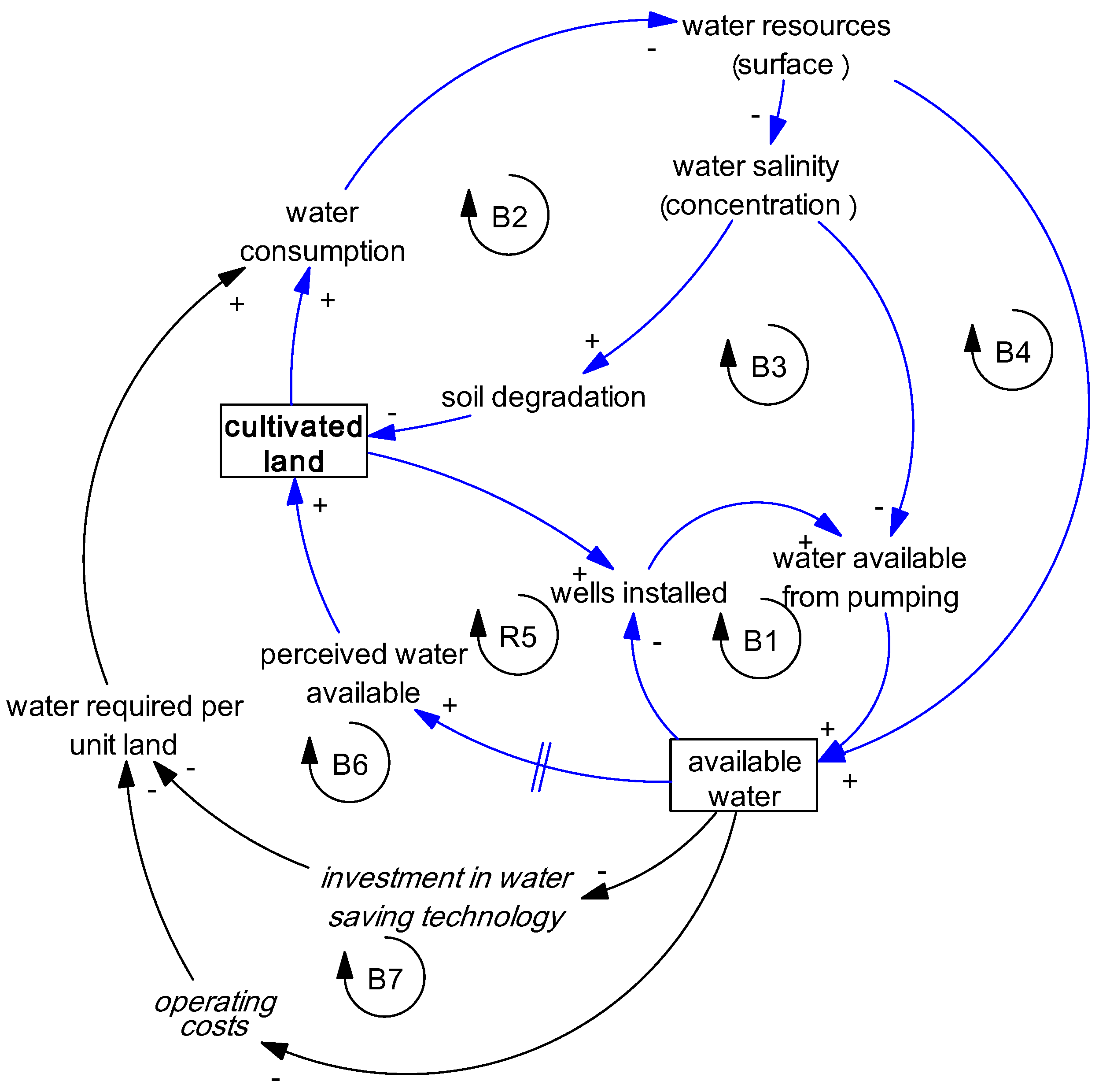
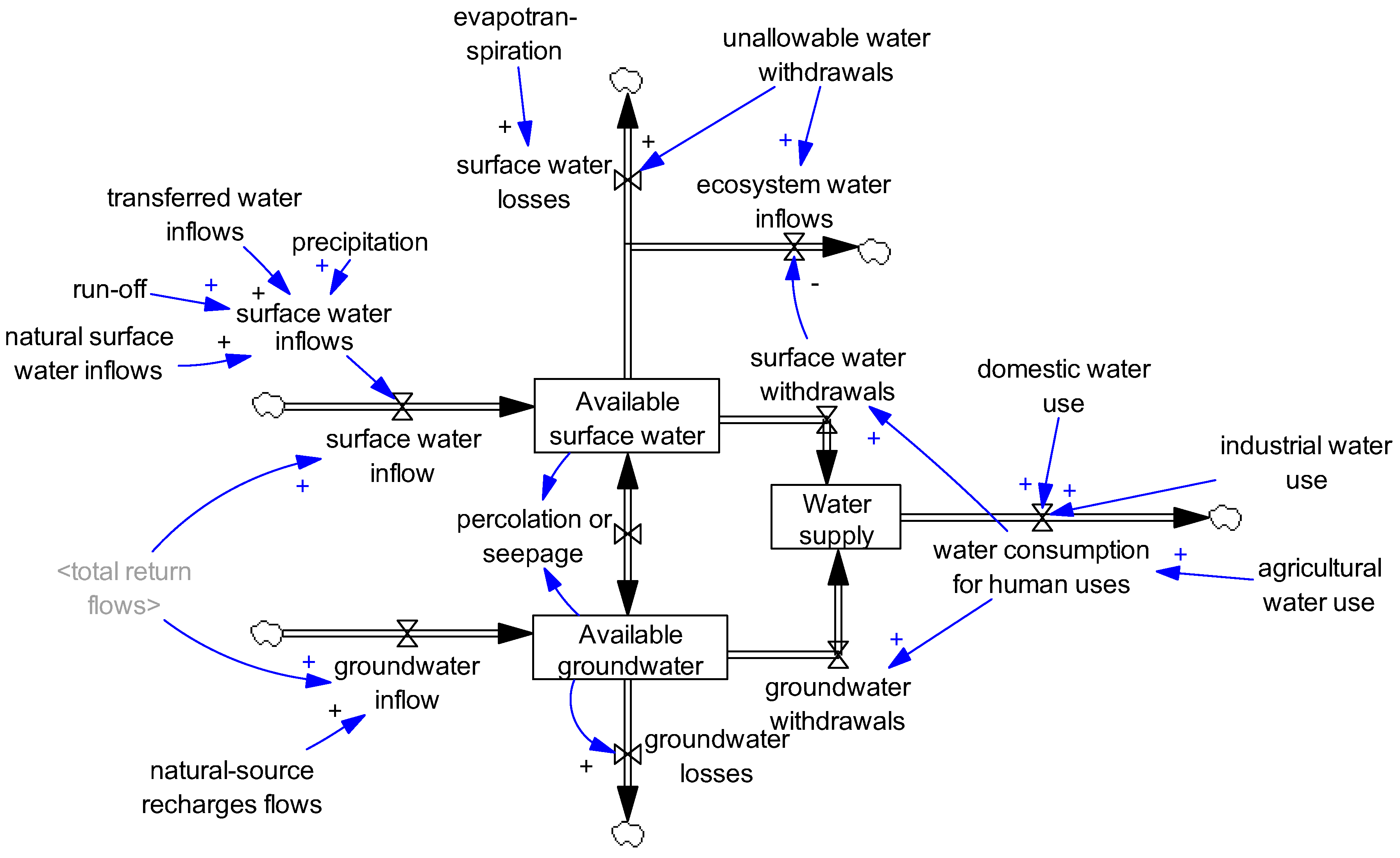

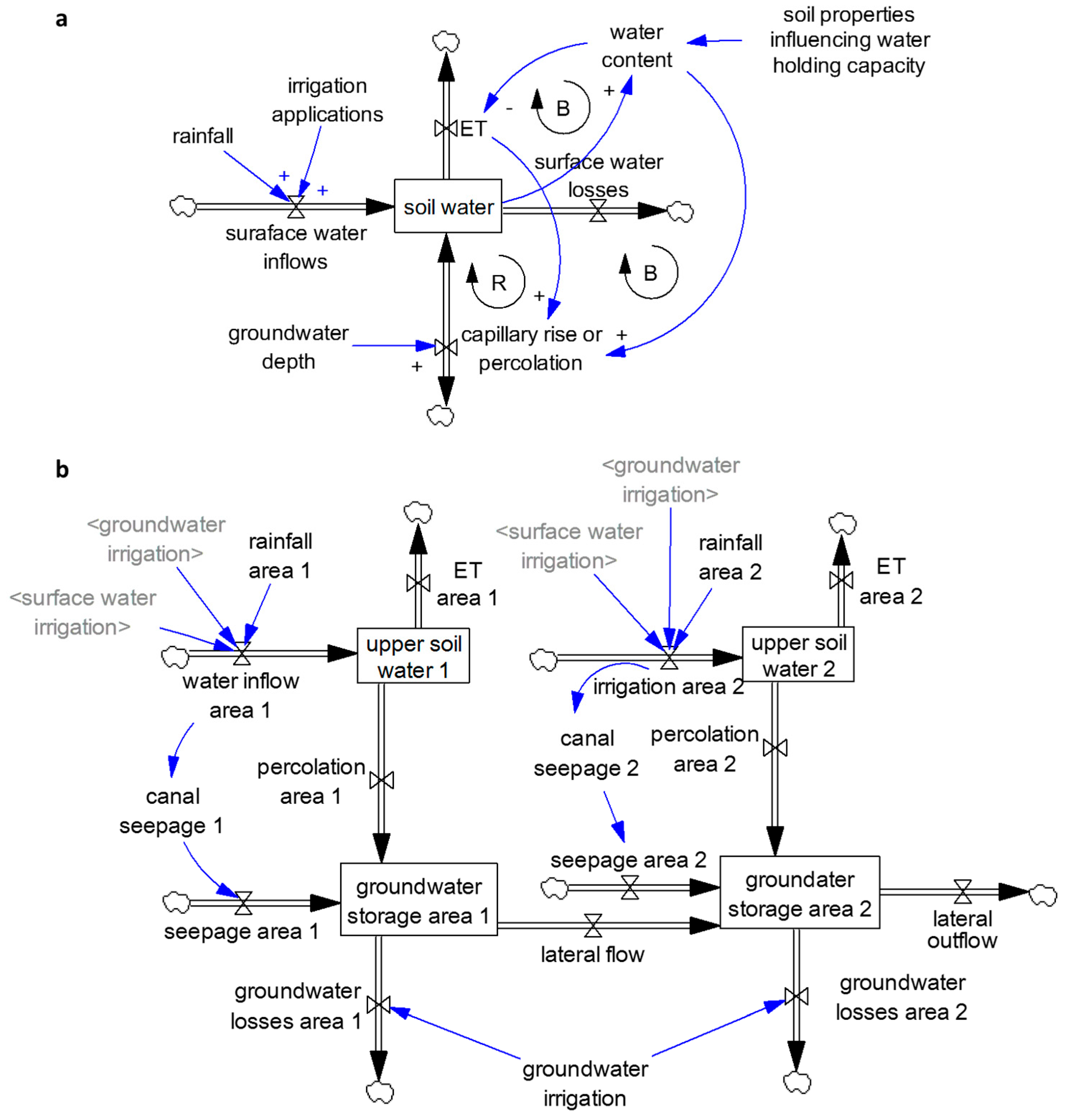
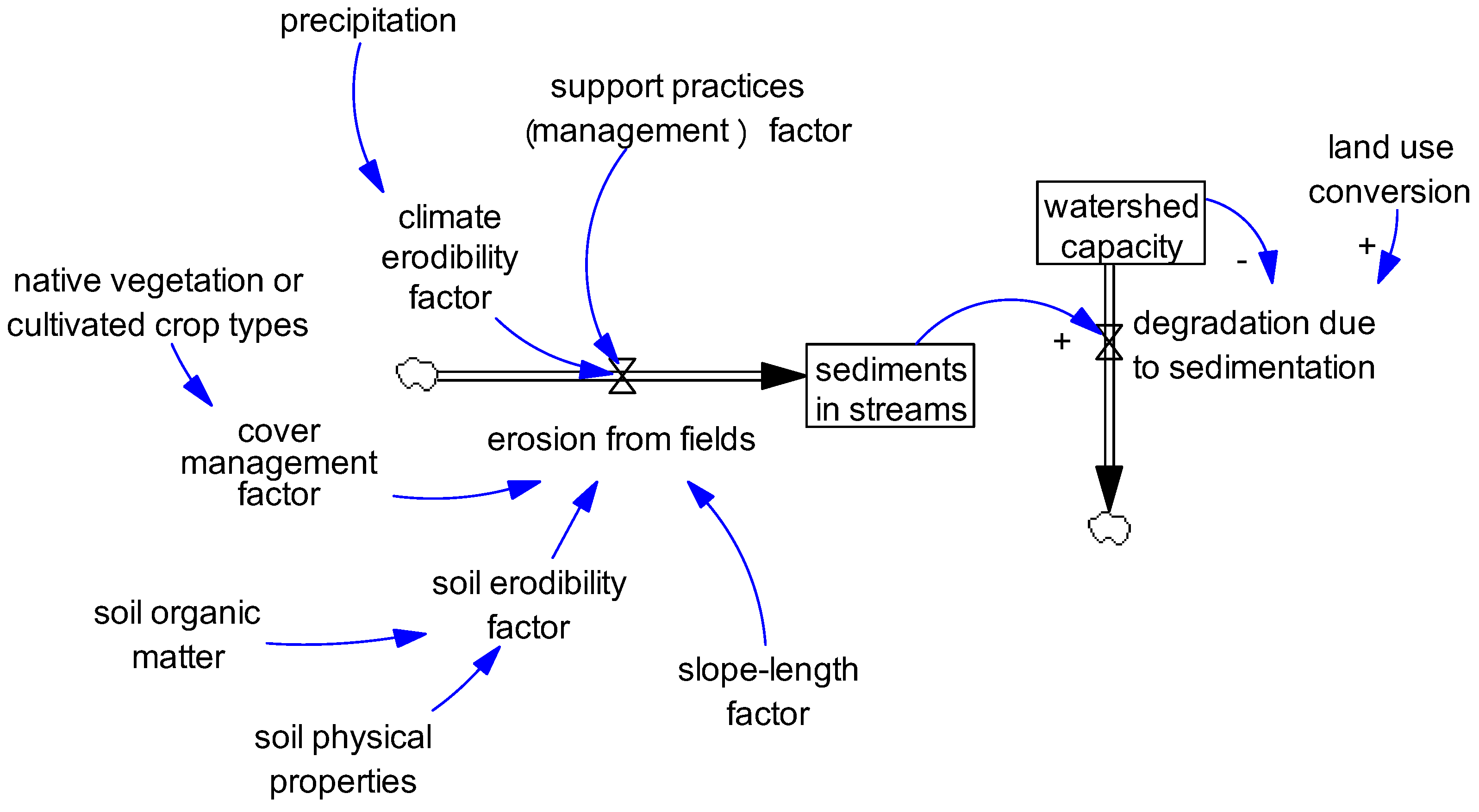


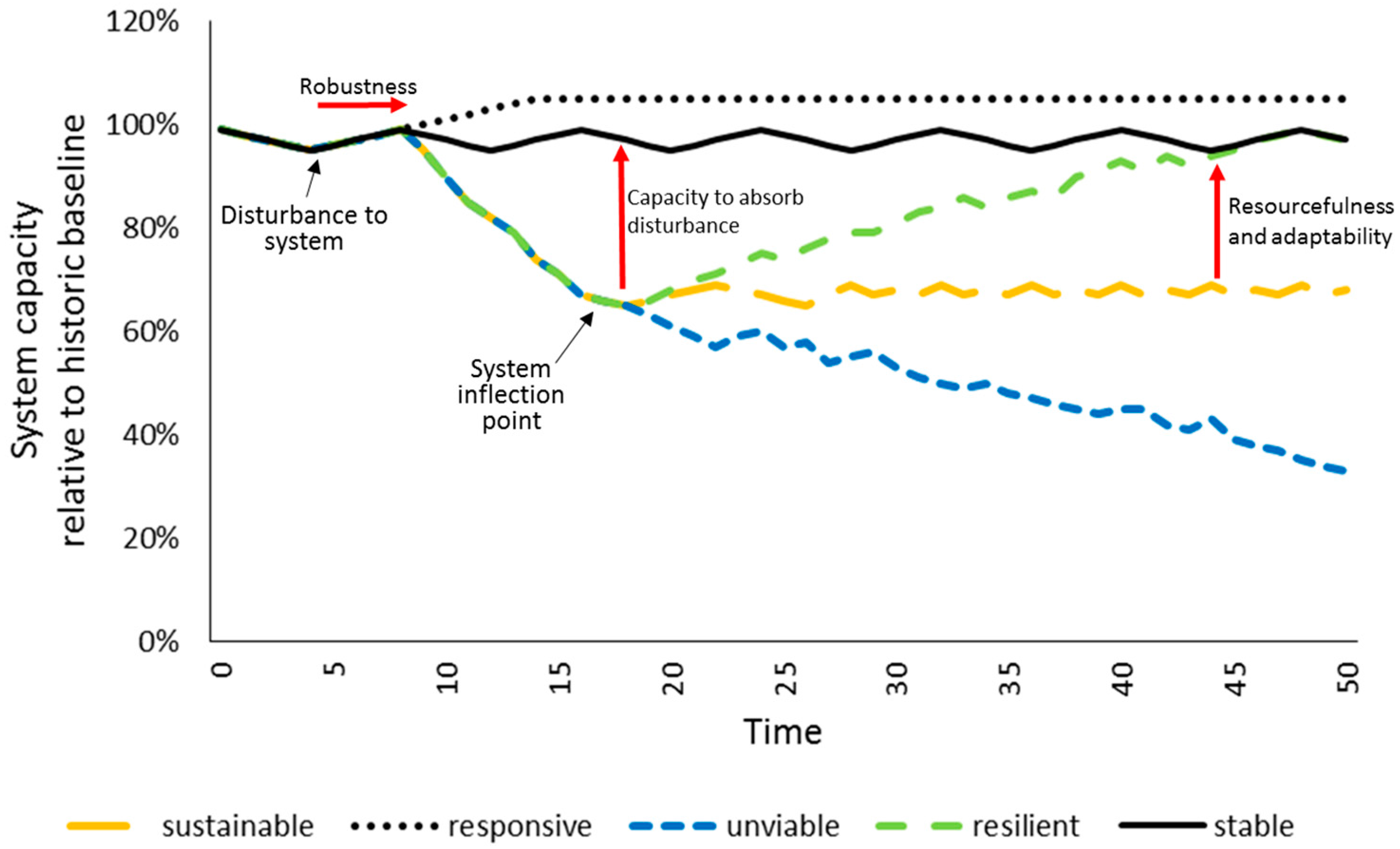
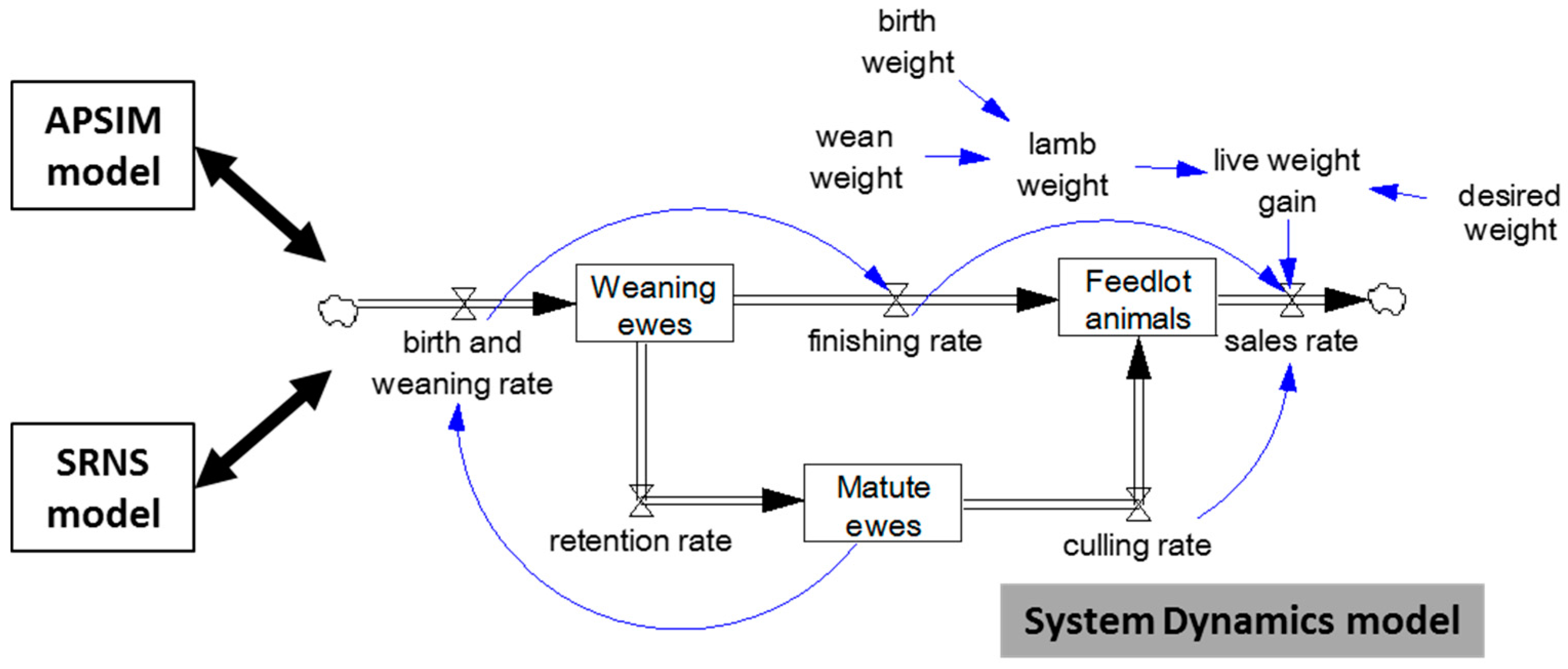

| Step of the Process 1 | Purpose/Objective 1 | Description of Activities 2 | Advice of Practitioners |
|---|---|---|---|
| 1. Problem articulation | Determine boundaries, variables, time horizons, and data sources | 1. Interviews/surveys 2. Describing mental models 3. Collecting/aggregating reference mode data | “Admire the problem” [34] |
| 2. Development of dynamic hypothesis | Initial explanation of the endogenous dynamics of the problem at hand | 1. Identify current theories of the problem 2. Causal loop diagramming 3. Stock-and-flow mapping | |
| 3. Formulation of a simulation model | Move from qualitative to quantitative understanding of the problem | 1. Specifying model structure, decision rules 2. Parameter estimation and setting initial conditions 3. Checking model consistency with dynamic hypothesis | “Challenge the clouds” [33,36] |
| 4. Testing the simulation model | Building confidence in the quantitative model | 1. Reference mode comparisons 2. Extreme condition testing 3. Sensitivity analyses | “Try to ‘break’ the model” [33,37] |
| 5. Policy/strategy design and analysis | Identifying leverage or tipping points | 1. Scenario design and analysis 2. Stakeholder outreach | “Ask ‚‘What if?’” [33] |
© 2016 by the authors; licensee MDPI, Basel, Switzerland. This article is an open access article distributed under the terms and conditions of the Creative Commons Attribution (CC-BY) license (http://creativecommons.org/licenses/by/4.0/).
Share and Cite
Turner, B.L.; Menendez, H.M.; Gates, R.; Tedeschi, L.O.; Atzori, A.S. System Dynamics Modeling for Agricultural and Natural Resource Management Issues: Review of Some Past Cases and Forecasting Future Roles. Resources 2016, 5, 40. https://doi.org/10.3390/resources5040040
Turner BL, Menendez HM, Gates R, Tedeschi LO, Atzori AS. System Dynamics Modeling for Agricultural and Natural Resource Management Issues: Review of Some Past Cases and Forecasting Future Roles. Resources. 2016; 5(4):40. https://doi.org/10.3390/resources5040040
Chicago/Turabian StyleTurner, Benjamin L., Hector M. Menendez, Roger Gates, Luis O. Tedeschi, and Alberto S. Atzori. 2016. "System Dynamics Modeling for Agricultural and Natural Resource Management Issues: Review of Some Past Cases and Forecasting Future Roles" Resources 5, no. 4: 40. https://doi.org/10.3390/resources5040040
APA StyleTurner, B. L., Menendez, H. M., Gates, R., Tedeschi, L. O., & Atzori, A. S. (2016). System Dynamics Modeling for Agricultural and Natural Resource Management Issues: Review of Some Past Cases and Forecasting Future Roles. Resources, 5(4), 40. https://doi.org/10.3390/resources5040040









